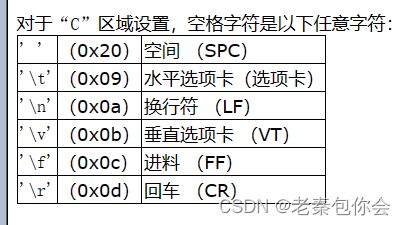C语言进阶第六课-----------字符分类函数和内存的开辟
作者前言
✨✨✨✨✨✨
作者介绍:
作者id:老秦包你会,
简单介绍:
喜欢学习C语言和python等编程语言,是一位爱分享的博主,有兴趣的小可爱可以来互讨
个人主页::小小页面
gitee页面:秦大大
一个爱分享的小博主 欢迎小可爱们前来借鉴
字符和内存
- **作者前言**
- 字符分类函数
-
- iscntrl
- isspace
- isdigit
- isxdigit
- islower
- isupper
- isalpha
- isalnum
- ispunct
- isgraph
- isprint
- 字符转换
-
- toupper
- tolower
- 内存相关函数
-
- memcpy
- memove
- memset
- memcmp
- 总结
字符分类函数
iscntrl
![]()
判断对应的ASCII值所对应的字符是否为控制字符
在ASCII码中,第0~31号及第127号(共33个)是控制字符或通讯专用字符,
如果 c 确实是控制字符,则与零(即 true)不同的值。否则为零(即假)。(是控制字符返回非0,不是就返回0)
#includeisspace
判断是否为空白字符
空白字符:空格‘ ’,换页‘\f’,换行’\n’,回车‘\r’,制表符’\t’或者垂直制表符’\v’
![]()
如果 c 确实是一个空格字符。返回非0(true), 否则为零(即假)。

#includeisdigit
判断字符是否是0-9
#include![]()
十进制数字是以下任意一种: 0 1 2 3 4 5 6 7 8 9 有
isxdigit
判断字符是否为十六进制的字母(包含大小写)和数字
十六进制数字是以下任意一种: 0 1 2 3 4 5 6 7 8 9 a b c d e f A B C D E F
![]()
是十六进制数就返回非0的数字,否则就返回0;
#includeislower
![]()
小写字母是以下任意字母:a b c d e f g h i j k l m n o p q r s t u v w x y z。
如果是小写字母就返回非0的数字,否则就返回0
#includeisupper
判断字符是否是大写字母
![]()
大写字母为以下任意字母:A B C D E F G H I J K L M N O P Q R S T U V W X Y Z。
如果是大写字母就返回非0的数字,否则就返回0
#includeisalpha
判断字符是否为字母(包含大小写)
![]()
如果是字母就返回非0的数字,否则就返回0
#includeisalnum
判断字符是否是字母或者数字
如果是字母或者是数字就返回非0的数字,否则就返回0
![]()
#includeispunct
![]()
检查字符是否为标点字符
如果是标点字符就返回非0的数字,否则就返回0

#includeisgraph
![]()
判断字符是否具有图形表示
具有图形表示的字符是除空格字符 (’ ') 之外的所有可以打印的字符(由 isprint 确定)。
#includeisprint
![]()
检查 c 是否为可打印字符
可打印字符是在显示器上占据打印位置的字符(这与控制字符相反,使用 iscntrl 检查)。
#include注意这里空格也是符合条件的
字符转换
前面我们只是理解了判断字符,如果要转换字符也有对应的库函数
toupper
![]()
小写字母是以下任意字母:a b c d e f g h i j k l m n o p q r s t u v w x y z,分别翻译为:A B C D E F G H I J K L M N O P Q R S T U V W X Y Z。
#include如果是小写就转换,不是就不转换
tolower
同理这个函数就是把大写转换成小写
#include如果是大写就转换,不是就不转换
内存相关函数
memcpy
前面我们已经学习过了strcpy,这个函数只适合于字符串拷贝,如果要拷贝整数数组,浮点型数组就会没办法,但是memcpy就可以解决
![]()
这个函数有三个参数,一个是目标空间,一个是起始地址,以及要拷贝的字节总大小
如果看过我模拟出来的qsrot函数就会明白,这里为啥要拷贝字节总大小,我们只把对应的字节大小进行拷贝过去
include<stdio.h>
int main()
{
int arr[20] = { 1,2,3,4,5,6,7,8,9 };
int arr1[10] = { 0 };
memcpy(arr1, arr, sizeof(int) * 9);
int i = 0;
for (i = 0; i < 10; i++)
{
printf("%d ", arr[i]);
}
return 0;
}
如果我们要模拟实现出来
#include如果当我们使用这个模拟函数进行自身部分的拷贝就会发现,和库函数memcpy有差异
#include库函数的结果
![]()
我们模拟函数的结果:
![]()
可以看出两者的差异
看到这里就会有疑问,是不是模拟错了?
其实标准值规定,memcpy来实现不重叠的内存拷贝,而重叠的内存拷贝一般不使用memcpy而是使用memmove,就好比我们考试只需考60分,90分就要其他人去考吧,而我们却发现memcpy连重叠的拷贝也能做到,这就是超预期了,而我们模拟出来的函数只是具备了拷贝不重叠的内存拷贝功能,vs的库函数memcpy两者具备,但是在一些编译器里就会不一定两种功能都有。
memove
![]()
从这里可以看出memmove函数的参数和memcpy是一样的,所以memove函数具备了memcpy的所有功能
#include我们来模拟一下

如果模拟这个函数很容易就会把memcpy的功能加上重叠的功能,重叠的方法很多人就会想到我要重新开辟一块临时空间存放和arr一样的,然后进行一一的拷贝,然后再覆盖原来的arr,这个方法是可行的,但是这样很麻烦,那有没有在一个数组内就可以进行拷贝呢?答案是有的
如上图
如果我们要3-7拷贝到1-5的位置上去,我们可以先把3拷贝到1然后依次往下,就可以解决原来数字被覆盖的问题,
如果我们要把1-5拷贝到5-9的位置我们就先拷贝5到9的位置上去,往后依次往前
#include这里我们要注意一下数组arr的第n个元素的地址是arr+(n - 1)
memset
![]()
填充内存块
把从ptr开始的num个字节填充为value
#include结果为:
![]()
所以我们可以认为memset是以字节为单位的进行设置的,如果不相信,下面为例
#include结果为:
![]()

这里就是arr里面 存储的内存,我们的想法是把arr每个元素设置成1,而结果却不对,memset是以字节为单位进行设置的,需要注意一下,在vs是小端存储(高阶数存放在低地址) 结果为01010101
如果我们要模拟实现就是
memcmp
![]()
比较两个内存块的内容
#include
简单的理解,和strcmp的比较方式是一样的,一旦匹配到不相等的内存就会返回
如果不相信还有一个例子
#include总结
到这里字符串相关的函数就学习完了,有不懂的可以私聊我
